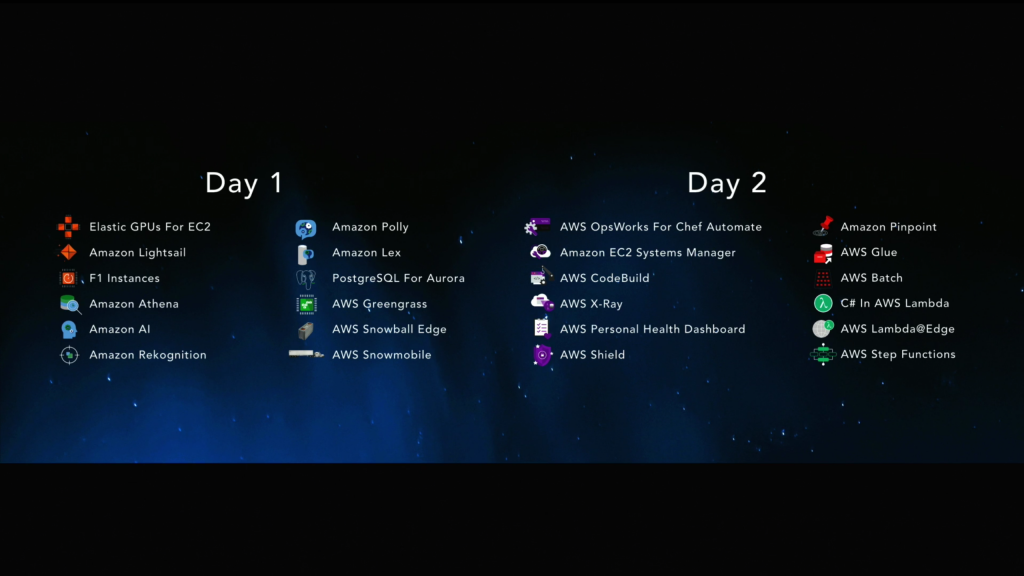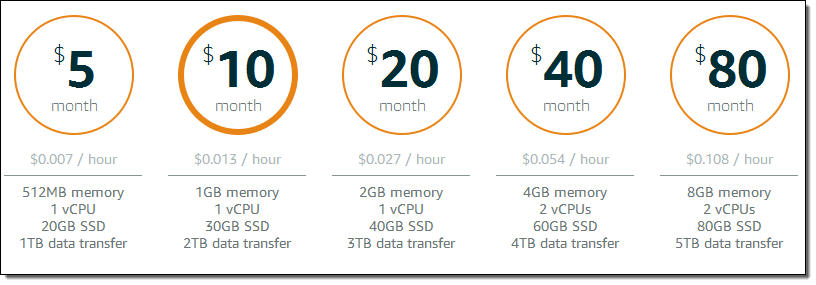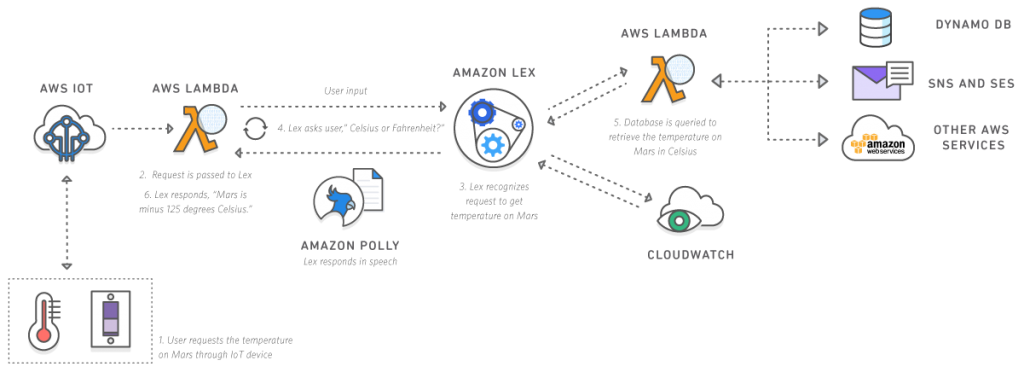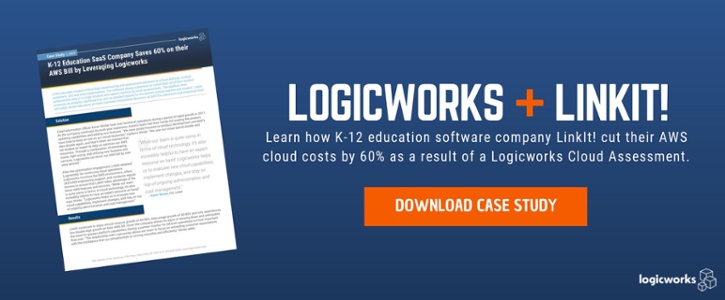Our engineers have gone to AWS re:Invent for many years now — but this year felt different. People in our industry have always paid attention to new AWS services, but as Amazon continues to leap ahead of major technology shifts and launch national conversations about things like IoT and analytics, this year’s re:Invent announcements are rippling out across a far wider business audience.
In terms of sheer numbers, this was the biggest re:Invent ever. More people, more breakout sessions, and Amazon’s biggest customer showcases yet (and yes, a really big truck). For those of you who could not make it this year, here are some of the most important new themes AWS emphasized through announcements at re:Invent — and our engineers’ reactions:

1. AWS is Diverse(r)
In the Wednesday keynote, Andy Jassy announced more varieties of compute instances — something he has done at every re:Invent, but nonetheless is always a powerful display of AWS’s market dominance and depth of services. Jassy announced:
- Elastic GPUs for EC2
- New sizes/varieties of T2, R4, I3, C5
- F1 instances with field-programmable gate arrays (FPGAs)
But Jassy’s core message is bigger than instance types; it is that, as Jassy said, no other cloud provider has even a third of the number of instance types that AWS has. AWS has depth. A very small percentage of users will use instance types like the F1 — but in side-to-side comparisons with other cloud providers, no one else even comes close. And that continues to matter.
2. Power to the Platform
If there is any core message to take out of re:Invent, it is that AWS is not content to be “just” an IaaS provider. Jassy, customers, and new announcements all emphasized the value of AWS’s managed tools, like Aurora, Simple Server Management (see below) and perhaps the most important service for the wider technology audience: Lightsail.
AWS Lightsail allows developers to launch virtual private servers (VPS) that start at $5/month. No need to provision storage, set up security, or do any custom fine-tuning, meaning Lightsail is targeted towards start-ups or standalone websites, not large enterprises. It is hard not to mention this service without saying that it is obviously a direct threat to Digital Ocean, which offers a similar service at the same price point.

AWS Lightsail pricing. Source: AWS
Jassy also launched Amazon Athena, a service that allows you to query S3 directly using standard SQL without spinning up clusters of instances. (Again, notice the platform theme.) Our engineers are already drooling over this service for its potential ability to query logs in Config, CloudTrail, and ELB.
In general, the PaaS message is also trying to convince enterprises to move beyond lift-and-shift. Obviously, if you are using AWS’s platform services, you are a stickier customer. But truthfully, the companies that we see with the greatest cost and agility benefits are those that have adopted AWS native services. Companies that really utilize the full breadth of AWS services lower ongoing management costs and reduce the effort of updating and upgrading their own tools. When fear of vendor lock-in keeps companies limited to EC2 and S3, they wind up burning valuable resources retrofitting their own tools and managing 3rd party solutions.
3. Some Big Love for Ops
The glamorous service announcement like analytics will get all the press, but it was great to see Werner focus so heavily on the nuts-and-bolts, distinctly unglamorous work of ongoing systems operations during his Thursday keynote.
- AWS Personal Health Dashboard: A tool that allows you to track the health of your environment, including things like instance reboots and decommissioning, and the ability to write a Lambda function to respond to these events. Very cool for a company like Logicworks that, in the past, had to write custom functions (in Jenkins) to track and respond to such events. This is an upgrade of a previous service, AWS Service Health Dashboard.
- AWS X-Ray: A fully-managed monitoring service for analyzing and debugging distributed applications in production. Werner showed screenshots of visualizations of bottlenecks — basically, seeing exactly where latencies between components and seeing where potential issues are coming from. Definitely a competitor to New Relic.
- EC2 Simple Systems Manager: Werner did not focus on this very long in his keynote, but this is a very, very cool service. Basically, it is a modular set of tools that allows you to configure and orchestrate EC2 instances, see the versions for components on each instance, have a patch management console, have a software inventory, and more. For enterprise that are looking for a consistent way to configure and manage their instances, this is a great tool. This system already existed, but this announcement represents a significant improvement.
- AWS OpsWorks for Chef Automate: Basically, AWS manages a Chef server for you.
These are the kinds of services that our engineers have been asking for — things that make the management of large-scale cloud computing environment easier.
4. IoT to the People
AWS unveiled IoT last year, but this year’s announcement is even more impressive: it is making the engine behind Alexa (Amazon Lex) available to developers along with Polly, a text-to-speech service. The combination of Lex + Polly means developers can easily build “conversational applications” — applications that allow you to book travel in a multi-stage conversation, for example. This is yet another signal that AWS will continue to be the foundation — and technical enabler — for innovation in the next ten years.

AWS IoT, Polly, and Lex at work supporting NASA’s Mars bot. Source: AWS
As a company that builds and manages thousands of VMs a year, we can confidently say it won’t be long before we are building entire computing environments with voice.
5. Amazon Sees Oracle as its Biggest Competitor (and Easiest Target)
In case you missed it, Jassy’s keynote was repeatedly…”hostile” to Oracle. This coming after the shots fired at Oracle that proclaimed it would beat AWS in the cloud.
Most customers couldn’t care less about this jockeying, but it was interesting that Jassy’s biggest laughs came at the expense of Oracle — and so keep an eye on any new Oracle services as a forecast of Amazon’s next announcements. Jassy announced PostgreSQL support for Aurora, which makes it easier for Oracle customers to migrate to Aurora.
6. Major Investments in Analytics
Amazon continues to release services that give you everything you need to create a complete analytics computing environment on AWS. AWS Glue is their new cornerstone analytics service, which does exactly as described — pieces together the various stages of data cataloguing, preparation, and job scheduling to work alongside their existing analytics services like EMR and Redshift. It is a fully managed ETL service that makes it easy to move data between your data stores. No more patching together various cloud-native and non-cloud-native services.
7. Open Source Container Management
It was widely expected that AWS would release an update to their Elastic Container Service, but the launch of AWS Blox, a collection of open source container management projects for ECS, is definitely an new direction for AWS. The open source container developer community is thriving — and for those who are not aware, Docker itself is open source — so it is very smart for AWS to keep in the tradition. This is one area where AWS knows innovation can happen faster outside of their own offices.
8. Making Lambda More Accessible
Werner’s announcements of AWS Lambda@Edge and AWS Step Functions are significant steps forward in serverless management. Step Functions was possible (but difficult) before, but the ability to coordinate Lambda functions using visual workflows makes development in Lambda more accessible.
At the end of the day, AWS has proven yet again why they succeed: because they release new services constantly (sometimes even when they are just the kernel of an idea) and iterate on them constantly. It is a message that both Werner and Jassy reiterated throughout their presentations, that the company that succeeds will be the company that responds to customers the fastest. This is no doubt a message everyone has already heard, but to see it carried out in such spectacular fashion by Amazon year after year is still impressive. Now onto the party.
Logicworks is an enterprise cloud automation and managed services provider with 23 years of experience transforming enterprise IT. Contact us to learn more about our managed cloud solutions.


